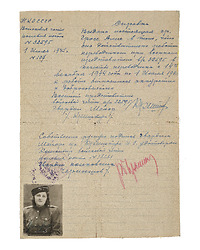Alice Grosz
1944, Budapest, Hungary
Alice runs into an acquaintance on the street. She is clad all in black but has folded up her widow’s veil, so her face is visible. The man recognises her. He was once engaged to one of Alice’s girlfriends and knows that she is Jewish.
IN MARCH 1944, the armies of Nazi Germany occupied Hungary. Thirty-year-old Alice Grosz lived in the country’s capital, Budapest, where she ran a creamery. Alice was unmarried and lived alone. There was a man in her life, Sándor. But he lived with his wife and three daughters in the town of Jászberény, east of Budapest.
Alice escaped the deportation of Budapest’s Jews in the autumn of 1944. She dressed as a Catholic war widow and obtained duplicate identity documents from one of her employees. The man she met on the street merely exchanged a few words with her and wished her luck. Alice was able to maintain her false identity.
In November 1944, the Soviet army reached Budapest. In addition to Hungarian and Yiddish, Alice spoke both Russian and German. She was hired by the Soviet army as an interpreter and worked for them until the end of the war.


